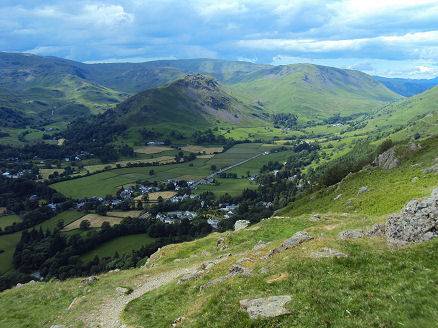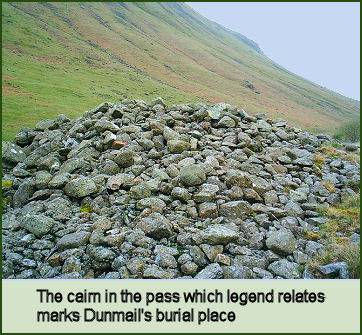Dunmail Raise
OS grid ref:- NY 349 079
Dunmail Raise marks the highest point (at 781 feet or 238 metres) of a pass on the Keswick-Kendal road, to the south of Thirlmere on the way to Grasmere. To its east is the ridge dominated by Helvellyn and Fairfield, and to the west lies the High Raise massif. The road which runs nearby is thought to have been an ancient routeway used far back into the Stone Age.
Dunmail Raise from Heron Crag

The pass was the scene of a bloody Dark Age battle for control of Cumbria between King Dunmail, the last King of Cumbria, and the combined forces of the Saxon king Edmund I and Malcolm, the King of Scots.
The Legend of Dunmail, Last King of Cumbria
 Dunmail, or Dyfnwal ab Owain, the last King of Cumbria (died 945) is a figure of both history and legend. The lands he ruled over probably covered Cumberland to Strathclyde , which represented the final stronghold of the Celtic British or 'Cumber'. He was the last of a long line of Cumbrian kings of ancient Celtic lineage. His father, Owain, supposedly the 'giant' buried at the Giant's Grave in Penrith, fought and lost at the great Battle of Brunanburh against the Saxon King Athelstan in 937 A.D.. In 945AD the Saxon king Edmund I conquered Strathclyde and granted Cumbria to his ally, Malcolm I King of Scots. The Anglo-Saxon Chronicle relates "A.D. 945. This year King Edmund overran all Cumberland; and let it all to Malcolm king of the Scots, on the condition that he became his ally, both by sea and land. "
Dunmail, or Dyfnwal ab Owain, the last King of Cumbria (died 945) is a figure of both history and legend. The lands he ruled over probably covered Cumberland to Strathclyde , which represented the final stronghold of the Celtic British or 'Cumber'. He was the last of a long line of Cumbrian kings of ancient Celtic lineage. His father, Owain, supposedly the 'giant' buried at the Giant's Grave in Penrith, fought and lost at the great Battle of Brunanburh against the Saxon King Athelstan in 937 A.D.. In 945AD the Saxon king Edmund I conquered Strathclyde and granted Cumbria to his ally, Malcolm I King of Scots. The Anglo-Saxon Chronicle relates "A.D. 945. This year King Edmund overran all Cumberland; and let it all to Malcolm king of the Scots, on the condition that he became his ally, both by sea and land. "
Legend relates that Dunmail was attacked by the combined forces of Edmund I and Malcolm, outnumbered, he retreated into the heart of his Lake District territory. He led the Cumbrians in their last stand for independence in a bloody and ferocious battle, fought in the pass that divides Grasmere from Thirlmere but it proved to be his last stand he was defeated and killed in the battle, it is related at the hands of Edmund himself, Dunmail's sons were subsequently blinded by the victors.
The legend also tells us that some of the surviving Cumbrians, taken prisoner by the Saxon Edmund, were ordered to collect rocks to pile on Dunmail's body, forming a cairn that still exists to this day and gives the pass its modern name, Dunmail Raise. Others of Dunmail's warriors fled with the crown of Cumbria, climbing into the mountains to Grisedale Tarn below Helvellyn, here the crown was thrown by his surviving followers into the tarn, where it sank, lost forever in the deep, dark water according to his last words 'My crown - bear it away; never let the Saxons flout it, until I come again to lead you.' Every year the warriors are said to return to the tarn, recover the crown and carry it down to the cairn on Dunmail Raise. There they strike the cairn with their spears and a voice is heard from deep inside the stones, saying "Not yet, not yet; wait awhile my warriors."
Dunmail is mentioned in Wordsworth's poem the Waggoner:-
The horses cautiously pursue
Their way, without mishap or fault;
And now have reached that pile of stones,
Heaped over brave King Dunmail's bones;
He who had once supreme command,
Last king of rocky Cumberland
His bones, and those of all his Power,
Slain here in a disastrous hour'
The death of Dunmail in 945 marked the end of the last vestige of the Celtic kingdom of Rheged, with its links to Britain' s pre-Anglo-Saxon past. Within fifty years, the Cumbrian people had stopped speaking their native language, a form of Brythonic Celtic which was similar to Welsh, once the speech of in the Hen Ogledd or "Old North", and used over an extensive region stretching from the River Eamont near Penrith to the northern tip of Loch Lomond in Scotland.
